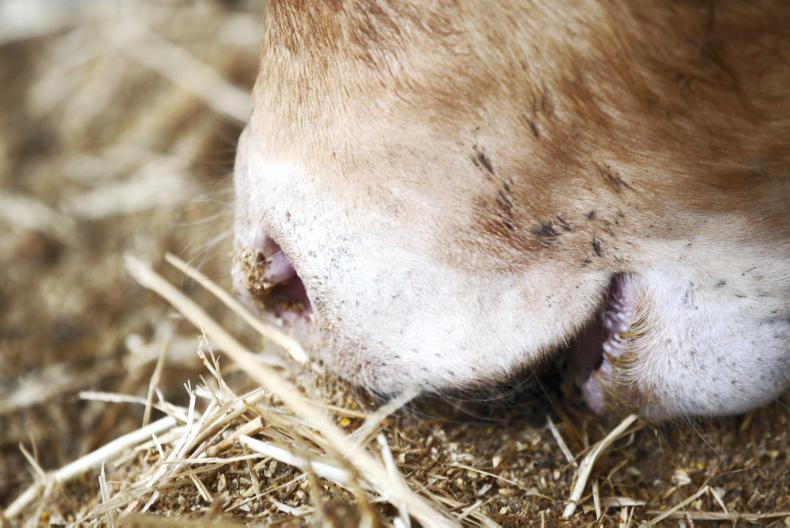After a wet summer and autumn, we are facing into a winter finishing period with variable silage quality.
Combined with the possibility of tighter silage supplies, farmers should be asking what the best feed option for finishing cattle is.
Cattle due to be finished within the next 100 to 120 days are now housed on the vast majority of farms. Finishing cattle indoors is expensive, so you need to ensure your animals are achieving high levels of liveweight gain to cover their daily feed costs.
Where silage harvesting was delayed, quality will be low. Therefore, to keep cattle growing at optimum performance, beef finishers have little choice but to offer higher levels of concentrates along with grass silage.
On average-quality silage (63 D-value units), steers need to be eating 7kg to 8kg of concentrate per day. Heifers will require 6kg to 7kg of concentrate per day.
At this level of silage quality and concentrate-feeding, you should consider the merits of moving these animals to an ad-lib concentrate-feeding system.
At these higher concentrate levels, steers and heifers are probably eating 10kg to 15kg of silage on a fresh-weight basis.
Average-quality silage with a feed value of 63 D-value, or lower, will be contributing very little towards daily liveweight gain in finishing cattle.
If anything, this quality of silage will be high in fibre, which will reduce feed intake.
Lower feed intake will mean the animal is taking in less energy. The end result is that finishing cattle would not be growing to their full potential.
Moving these animals on to an ad-lib diet will improve cattle performance. But there are several factors to be considered before going down this route. These are:
1. Silage quality
Get your silage tested to determine feed value. If silage is low in energy (<10 ME), protein (<11%) and below 63 D-value, then ad-lib finishing should be considered as an option, as silage will support little in the way of liveweight gain.
Similarly, if you have a limited supply of good-quality silage, then you should still consider moving cattle on to an ad-lib concentrate-finishing system now, rather than upsetting the animal’s diet closer to finishing weight. If this is the case, it is important to make the decision early.
2. Animal type
While bulls suit ad-lib concentrate feeding over a long-term period, steers and especially heifers are less suited.
The finishing period will be much shorter, with forward steers reaching the correct finish spec in 80 to 100 days and heifers in 50 to 70 days.
Fat cover has to be closely monitored on ad-lib feeding. Traditional beef breeds, such as Angus and Shorthorn, are less suitable for ad-lib finishing compared with continental beef breeds.
3. Ration type
Normally you would be looking to keep protein levels as low as possible in a finishing diet. But in this case, protein may be of benefit to prevent certain cattle types from becoming too fat too soon.
You won’t need a 16% protein ration, a 14% ration will suffice with an ME of 12 or higher. You can buy a nut, or blend for ease storage, or due to the lack of feeding equipment.
If you have the option to home-mix concentrate, it may work out cheaper at current ration prices.
Compound ration prices have been slow to drop, despite lower cereal prices over the past two years.
A three-way mix of barley, soya hulls and soya, or distillers, will provide a good mix of energy, protein and starch to aid the finishing of cattle. Match target protein content to animal type.
4. Housing weight
Cattle need to be housed within 60kg to 120kg of finishing weight for ad-lib concentrate finishing to be an option for steers and heifers. Lighter housing-weights will require storing for a period.
5. Management
Ad-lib feeding requires high levels of management. It is not just a matter of filling the trough and leaving animals to it.
Cattle have to be built up to ad-lib levels gradually and, once on these higher concentrate levels, it is vital that they never run out of feed.
If they do, there is a risk of cattle gorging on concentrate the next time you fill the trough.
This can lead to acidosis. If they do run out of feed, you will have to build them back up to ad-lib feeding again.
Cattle also require at least 20% of their DM intake to be in the form of roughage – either as straw or high-fibre silage.
Water intake is also important. Cattle will drink roughly six litres of water for every 1kg of concentrate consumed. Water has to be kept fresh.






 This is a subscriber-only article
This is a subscriber-only article










SHARING OPTIONS: